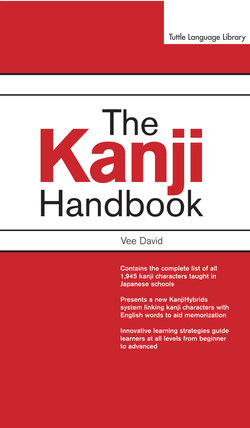Читать книгу Kanji Handbook - Vee David - Страница 7
На сайте Литреса книга снята с продажи.
ОглавлениеPreface
Linguistic scholars largely agree that Japanese is the most difficult second language to learn. With four different writing systems, those eager to learn Japanese have a long and demanding journey to undergo. Thus, the Kanji Handbook was conceived to map out learning strategies to systematically guide learners from beginner to advanced level in Kanji literacy. Unique learning tools were designed for this book to resolve the many aggravations commonly encountered by Kanji learners. All 1,945 Jōyō Kanji characters—the most commonly used Kanji characters as officially prescribed by the Japanese Ministry of Education since 1981—can be learned through this book. The Kanji Handbook was fashioned to offer an end to some of the most discouraging problems facing those who study Kanji characters. The biggest struggle in learning the 1,945 Kanji characters is the mission of memorizing them, their shades of meaning, myriad pronunciations and compounds. To encourage memory retention, all Kanji characters in this book appear as KanjiHybrids, or the combination of a Kanji character and its English meaning to form one, integral and indivisible unit. In addition, the pioneering concept of Veemuenics—where similar looking Kanji characters are placed as KanjiHybrids in a rhyming English sentence or phrase—will further help learners remember each Kanji character and the slight differences between them. For example:
| KanjiHybrid: | 皇mperor, 星tar, 星lanet |
| Veemuenic: | Roman 皇mperors shine like 星tars even from 星lanets afar... |
The concept of Veemuenics was created to help learners differentiate between the similar-looking Kanji characters nearly undistinguishable to beginners. Some Kanji characters may only differ because of a dash or a stroke, or a radical. In many cases, these slight differences only become visible after years of careful study and consistent use. How does one discern the difference between 皇 and 星? To manage this problem, each Kanji character presented in this book has a corresponding list of similar-looking Kanji characters as not to confuse them. Diligent practice of writing the Veemuenics will serve the purpose of differentiating between similar-looking Kanji characters.
Another major hindrance for Kanji beginners is the lack of adequate learning tools. To find a Kanji character in the dictionary, one must know the Kanji character’s stroke order, radical, ON-yomi or KUN-yomi readings. These prerequisites make it frustrating and utterly confusing for beginners. How does an absolute beginner search for 豊 and 農 without knowing anything? To that end, the Flip-It Index was created to allow absolute beginners to search for a Kanji character's meaning without knowing any basics whatsoever. To use the Flip-It Index, all one has to do is decide if a Kanji character is flippable, looking the same when inverted horizontally, non-flippable or partially-flippable to a certain degree. This simple, artistic way of finding the meaning of a Kanji character is a revolutionary learning tool designed to take the prerequisite guess work out of Kanji study. Finally, a new indexing system was created for this book to address some inadequacies. Usually, Kanji indices only list the page number in which to find each Kanji character, without the English core meaning. This process of first finding a Kanji character in the index, and then having to search for its corresponding page to know the core meaning, is time consuming and cumbersome. Additionally, sometimes learners confuse similar-looking Kanji characters and look up the wrong page, and have to begin all over again. These annoyances are quickly resolved in this book's indices of all 1,945 Kanji characters together with their English core meaning and corresponding page number.
These innovative problem-solving novelties make the Kanji Handbook radically different from other Kanji books. The study of Kanji characters has never been easier or enjoyable. With the publication of this book, learners will ideally find their journey to be a rewarding experience, thereby enriching Kanji characters as one of the most powerful mediums of world civilization.
